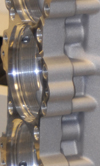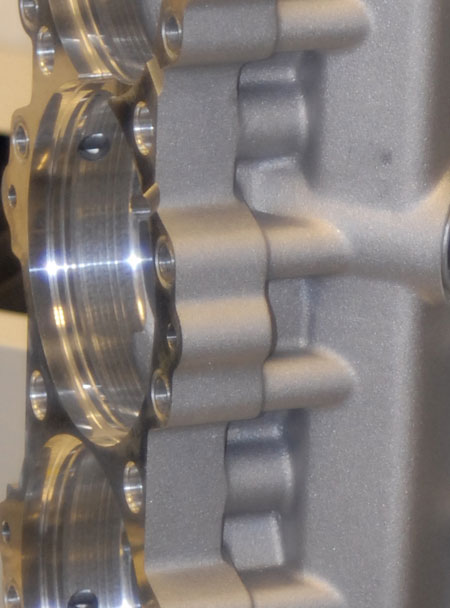Casting porosity
 As anyone who has ever built and tested prototype engines will vouch, apart from not getting the thing to fire and run, the next nightmare is the steady drip, drip, drip of a fluid on the dyno test bed's undertray.
As anyone who has ever built and tested prototype engines will vouch, apart from not getting the thing to fire and run, the next nightmare is the steady drip, drip, drip of a fluid on the dyno test bed's undertray.
Large leaks - whether oil or coolant - are, funnily enough, usually the easiest to solve, where a loose bolt or a forgotten hose clip are generally quickly dealt with. Worse by far though are the slight 'weeps' - the leaks that appear out of nowhere, travel down to a joint, run across the engine and down to the sump before finally spoiling your spotlessly clean drip tray underneath. Apart from the risk of fire, such a leak is annoying in a test cell, and unacceptable in a vehicle.
To the inexperienced it may look as though a gasket is not seating properly or that an 'O' ring has become dislodged. By now, however, the more experienced will be far less optimistic and will be suspecting a range of other causes - of which the worst possible is casting porosity.
Thanks to modern CAD methods and mould-flow casting programs, the integrity of metal castings is now better than ever. Low-pressure casting techniques, improved metallurgy and better understanding of the processes involved have combined to produce components that are approaching the quality in some cases of that of billet machined parts. For production parts, the skills and efforts required, as well as the costs - together with some trial and error - will eventually produce a casting free of porosity.
But for prototypes with limited budgets, for most of us the only sensible approach is one of caution and to seal any potential porosity from new. One such process used for almost 50 years is that provided by Impregnation Services of Lancashire, England.
The process starts with gently heating the bare casting - iron, aluminium or whatever -to about 120 C for several hours, to drive out any moisture. The dried components are then placed in a large autoclave and the pressure reduced to 10 mbar absolute or below. This has the effect of evacuating all the voids within the material in readiness for impregnation with a very low-viscosity (less than that of water) methacrylate liquid resin.
With no air present the resin has little option but to fill any voids in the casting, although in certain cases a pressure cycle of up to 7 bar can be introduced as well to consolidate it. Drained and centrifuged to recover as much of the surplus resin as possible, the components then go through a two-stage washing process to emulsify any remaining surface product.

After this, the resin retained in the casting undergoes a thermal cure in a hot bath at 95 C. Referred to as a thermosetting resin, the temperature triggers the catalyst in the resin to cross-link the polymer chains, producing a hard, glass-like substance with excellent sealing properties.
To be 100% effective, however, the casting should be treated from new. While there are techniques to remove contaminants such as oils or other fluids, successfully purging them cannot always be guaranteed. Nor can the process bind cracks together. In this case the component should be welded first and then returned for impregnation afterwards just to be sure.
When you consider how much time and effort goes into producing prototype parts, however, it is surely a false economy not to impregnate such items as a matter of course - even if only to let the test engineer sleep soundly at night.
Fig. 1 - Casting porosity
Written by John Coxon